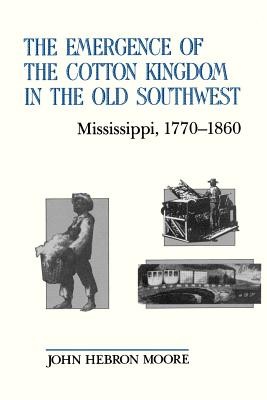
- We will send in 10–14 business days.
- Author: John Hebron Moore
- Publisher: LSU Press
- ISBN-10: 0807114049
- ISBN-13: 9780807114049
- Format: 15.4 x 22.8 x 2.4 cm, softcover
- Language: English
- SAVE -10% with code: EXTRA
The Emergence of the Cotton Kingdom in the Old Southwest (e-book) (used book) | bookbook.eu
Reviews
Description
The Old South's Cotton Kingdom arose simultaneously in two widely separated localities, the backcountry of the South Atlantic states and the east bank of the Mississippi River. Spreading from these places of origin and later merging, the east and west branches of the upland short-staple cotton industry developed along similar lines until the Civil War.John Hebron Moore's The Emergence of the Cotton Kingdom in the Old Southwest: Mississippi, 1770--1860 traces the evolution of cotton culture in the region bordering the Mississippi River. Moore examines the society supported by that industry, emphasizing technological changes that transformed cotton plantations into agricultural equivalents of factories and slaves into Mule-drawn equipment led to the introduction of improved methods of managing plantation slaves, and that in turn altered the nature of plantation slavery significantly.Moore focuses on Mississippi as both the pioneer cotton state of the Old Southwest and the Old South's leading producer of cotton between 1835 and 1860. Progressive planters made major contributions ot the success of the antebellum upland cotton industry, including the breeding of superior varieties of cotton, the introduction of improved farm implements and machinery, the development of effective methods of combating soil erosion, and systems for managing slaves based upon incentives rather than coercion. In addition, unlike other studies of antebellum southern agriculture, this book examines the contributions to the success of cotton industry made by steamboats and railroads, manufacturing establishments, and the urban population.
EXTRA 10 % discount with code: EXTRA
The promotion ends in 18d.22:29:21
The discount code is valid when purchasing from 10 €. Discounts do not stack.
- Author: John Hebron Moore
- Publisher: LSU Press
- ISBN-10: 0807114049
- ISBN-13: 9780807114049
- Format: 15.4 x 22.8 x 2.4 cm, softcover
- Language: English English
The Old South's Cotton Kingdom arose simultaneously in two widely separated localities, the backcountry of the South Atlantic states and the east bank of the Mississippi River. Spreading from these places of origin and later merging, the east and west branches of the upland short-staple cotton industry developed along similar lines until the Civil War.John Hebron Moore's The Emergence of the Cotton Kingdom in the Old Southwest: Mississippi, 1770--1860 traces the evolution of cotton culture in the region bordering the Mississippi River. Moore examines the society supported by that industry, emphasizing technological changes that transformed cotton plantations into agricultural equivalents of factories and slaves into Mule-drawn equipment led to the introduction of improved methods of managing plantation slaves, and that in turn altered the nature of plantation slavery significantly.Moore focuses on Mississippi as both the pioneer cotton state of the Old Southwest and the Old South's leading producer of cotton between 1835 and 1860. Progressive planters made major contributions ot the success of the antebellum upland cotton industry, including the breeding of superior varieties of cotton, the introduction of improved farm implements and machinery, the development of effective methods of combating soil erosion, and systems for managing slaves based upon incentives rather than coercion. In addition, unlike other studies of antebellum southern agriculture, this book examines the contributions to the success of cotton industry made by steamboats and railroads, manufacturing establishments, and the urban population.


Reviews